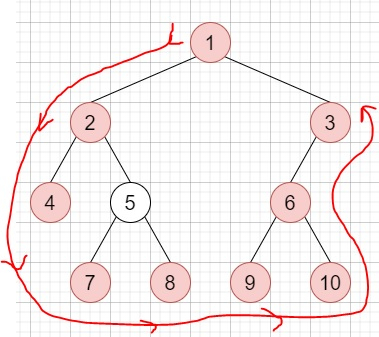C++ 中二叉树的边界
假设我们有一棵二叉树,我们必须从根开始逆时针方向找到其边界的值。这里的边界包括左边界、叶子和右边界,顺序不重复。
左边界是从根到最左边节点的路径。
右边界是从根到最右边节点的路径。
当根没有左子树或右子树时,根本身就是左边界或右边界。
所以,如果输入是这样的

那么输出将是 [1,2,4,7,8,9,10,6,3]
要解决为此,我们将遵循以下步骤 −
定义一个数组 ret
定义一个函数 leftBoundary(),它将获取节点,
如果节点为空或节点为叶,则 −
return
将节点的值插入到 ret 中
如果节点的左侧存在,则 −
leftBoundary(left of node)
Otherwise
leftBoundary(right of node)
定义一个函数 rightBoundary(),它将接受节点,
如果节点为空或节点为叶,则 −
return
将节点的值插入到 ret 中
如果节点的右侧存在,则 −
rightBoundary(left of node)
否则
rightBoundary(right of node)
定义一个函数 leaves(),它将获取节点,
如果节点不存在,则 −
return
如果节点是叶子,则 −
将节点的 val 插入到 ret 中
leaves(left of node)
leaves(right of node)
从 main 方法执行以下操作 −
清除 ret 数组
如果 root 不存在,则 −
return ret
将 root 的 val 插入到 ret 中
leftBoundary(left of root)
leaves(left of root);
leaves(right of root);
rightBoundary(right of root)
return ret
示例
让我们看下面的实现,以便更好地理解 −
#include <bits/stdc++.h>
using namespace std;
void print_vector(vector<auto> v){
cout << "[";
for(int i = 0; i<v.size(); i++){
cout << v[i] << ", ";
}
cout << "]"<<endl;
}
class TreeNode{
public:
int val;
TreeNode *left, *right;
TreeNode(int data){
val = data;
left = NULL;
right = NULL;
}
};
void insert(TreeNode **root, int val){
queue<TreeNode*> q;
q.push(*root);
while(q.size()){
TreeNode *temp = q.front();
q.pop();
if(!temp->left){
if(val != NULL)
temp->left = new TreeNode(val);
else
temp->left = new TreeNode(0);
return;
}else{
q.push(temp->left);
}
if(!temp->right){
if(val != NULL)
temp->right = new TreeNode(val);
else
temp->right = new TreeNode(0);
return;
}else{
q.push(temp->right);
}
}
}
TreeNode *make_tree(vector<int> v){
TreeNode *root = new TreeNode(v[0]);
for(int i = 1; i<v.size(); i++){
insert(&root, v[i]);
}
return root;
}
class Solution {
public:
vector<int> ret;
void leftBoundary(TreeNode* node){
if (!node || node->val == 0 || (!node->left && !node->right))
return;
ret.push_back(node->val);
if (node->left && node->left->val != 0)
leftBoundary(node->left);
else
leftBoundary(node->right);
}
void rightBoundary(TreeNode* node){
if (!node || node->val == 0 || (!node->left && !node->right))
return;
if (node->right && node->right->val != 0) {
rightBoundary(node->right);
}
else {
rightBoundary(node->left);
}
ret.push_back(node->val);
}
void leaves(TreeNode* node){
if (!node || node->val == 0)
return;
if (!node->left && !node->right) {
ret.push_back(node->val);
}
leaves(node->left);
leaves(node->right);
}
vector<int> boundaryOfBinaryTree(TreeNode* root){
ret.clear();
if (!root)
return ret;
ret.push_back(root->val);
leftBoundary(root->left);
leaves(root->left);
leaves(root->right);
rightBoundary(root->right);
return ret;
}
};
main(){
Solution ob;
vector<int> v = {1,2,3,4,5,6,NULL,NULL,NULL,7,8,9,10};
TreeNode *root = make_tree(v);
print_vector(ob.boundaryOfBinaryTree(root));
}
输入
{1,2,3,4,5,6,NULL,NULL,NULL,7,8,9,10}
输出
[1, 2, 4, 7, 8, 9, 10, 6, 3, ]


